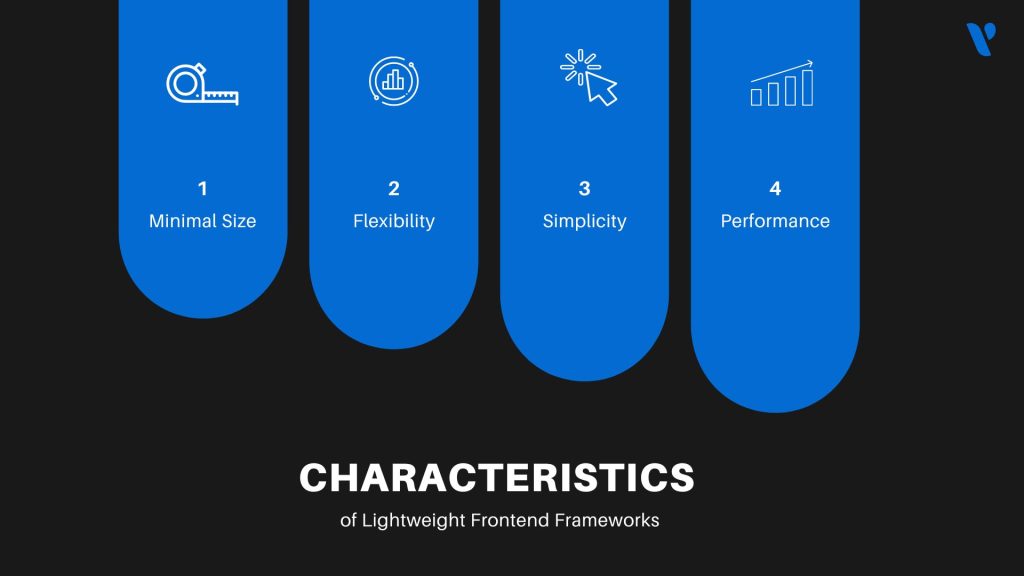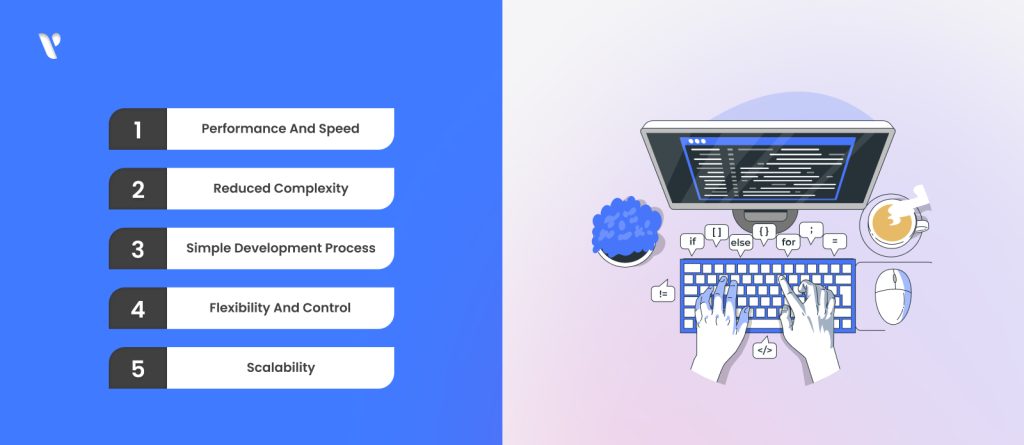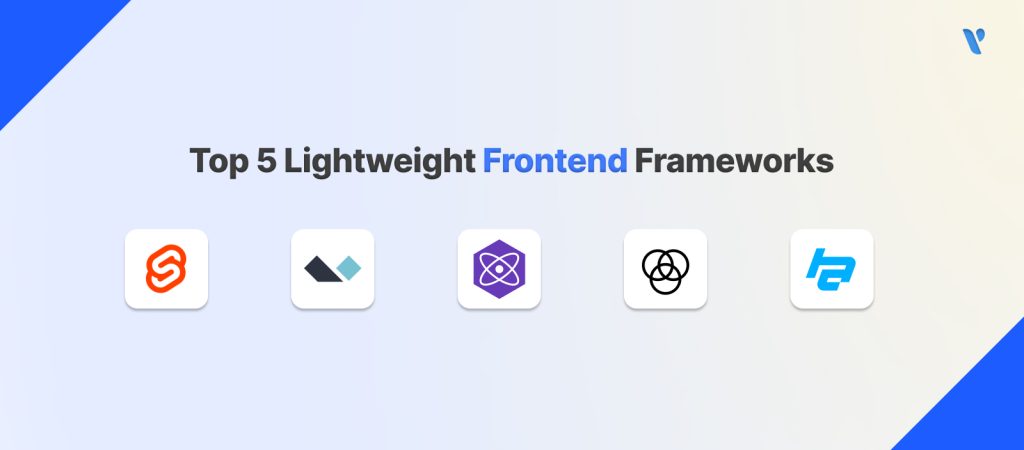Lightweight Frontend Frameworks for Fast Projects in 2025

When starting a basic online project, have you ever been confused by the huge amount of tools needed? It is important to have speed and simplicity in the dynamic field of web development, particularly when clients want rapid turnarounds and deadlines are short. In order to assist developers launch projects more quickly and effectively without the bloat of standard technologies.
This blog digs into the area of lightweight frontend frameworks. We will analyze how these reduced technologies could impact your development process, from their simplicity of use to their performance advantages.
A front-end framework is a set of essential tools, code libraries, and components that make it easier to design appealing user interfaces for websites and web apps. The ideal front-end framework for a web development company offers a variety of ready-made modules, styling options, and tools for managing data and interactivity. This allows developers to focus on adding unique features to the app or website.
Lightweight frontend frameworks are quick and easy-to-use solutions that make apps for the web simple and effective to develop. “Lightweight” refers to the fact that these frameworks offer all the essential capabilities required to develop user interfaces, without adding the extra weight associated with bigger, complex systems. These frameworks have become popular because they are easy to use, load quickly, and consume less resources.

The following are the Characteristics of Lightweight Frontend Frameworks:

Lightweight frontend frameworks are quite useful, especially in rapid development environments. The following are the reasons why you need Lightweight Frontend Frameworks:
Performance drives the demand for lightweight frontend frameworks. Users expect fast loading websites and apps as digital use increases. Large frameworks can slow load times, especially on mobile devices or with weak internet connections.
In contrast, lightweight frontend frameworks prioritize performance throughout design. Their reduced physical size results in quicker load times and an improved user experience. This speed is important for keeping customers coming back because research indicates that even a one-second lag in page load time may cause a noticeable decline in user engagement and satisfaction.
Lightweight frontend frameworks are often simpler than their more packed with features equivalents. They are simpler to understand and operate, which is especially helpful for smaller teams or single engineers. These developers won’t be distracted by the intricacies of a bigger framework and can concentrate on creating useful products. The development process is simplified by the lower learning curve.
A more straightforward and efficient development approach is provided by lightweight frontend frameworks. Lightweight frameworks focused on the fundamentals, in contrast to bigger, more feature-rich frameworks, which can have steep learning curves and a wide range of tools and possibilities.
Because of its simplicity, developers can create apps more rapidly without getting slowed down by unnecessary complication. This may be a game-changer for smaller projects or teams with less resources, allowing easier maintenance and a quicker time to market.
The degree of freedom that lightweight frameworks offer is another important benefit. Larger frameworks sometimes enforce a certain structure or method of operation, which may be constrictive. Lightweight frameworks, on the other hand, provide developers greater control over their codebase.
More customization and the ability to incorporate just the precise features and tools required for a given project are made possible by this flexibility. By combining and matching libraries, developers may keep their applications as lightweight and efficient as possible.
Lightweight frontend frameworks may be basic, but they are frequently quite adaptable, allowing them to grow with new tools or libraries as the project does. Because of this adaptability, developers don’t have to change frameworks in order to start with a lightweight solution and grow up their applications as needed. It offers the flexibility to expand and modify the application in response to shifting needs.

Now that we’ve talked about why lightweight frameworks are useful, let’s look at the top 5 available right now. Each of these frameworks has its own benefits, depending on what your project needs.
Due to its creative approach to user interface design, Svelte has been causing quite a stir within the web development world. With Svelte, the majority of the work is done at the compile time rather than the browser, in contrast to more conventional frameworks like React or Vue. Consequently, there is no need for a virtual DOM or other bulky runtime libraries, making Svelte programs extremely lightweight and quick.
| Pros | Cons | Best Use Cases |
Smaller bundles and quicker performance are the results of Svelte’s efficient JavaScript compilation from component parts. | Svelte, being newer than React or Angular, has fewer third-party plugins and libraries available. | Svelte is perfect for creating reusable component libraries because of its minimal footprint. |
| Svelte’s clear syntax makes it easy for JavaScript developers to learn. | Svelte’s basic functions are simple, but its complex features and best practices might have a learning curve. | Single Page Applications (SPAs): When speed and performance are important, Svelte is ideal. |
| Svelte compiles components into efficient JavaScript, removing framework overhead for lighter, faster code. | Svelte, being newer, lacks some popular best practices and patterns found in older, more established frameworks. | Svelte is a great option for instantly prototyping ideas due to its simplicity and ease of usage. |
It’s common to refer to Alpine.js as the “Tailwind of JavaScript frameworks.” With a far lower footprint than frameworks like Vue or React, it’s a minimalist framework that offers the declarative and reactive features of those programs. For developers looking for a more manageable option to these more complex frameworks for incorporating interaction into their websites, Alpine.js is ideal.
| Pros | Cons | Best Use Cases |
| Alpine.js has a simple syntax and enhances HTML with interactive elements without needing a large framework. | Alpine.js has a smaller community and fewer resources for help and debugging compared to larger frameworks. | Where it would be impractical to introduce a full SPA framework, Alpine.js can be readily incorporated into existing applications. |
Alpine.js does not require a whole rework of your present stack in order to be seamlessly incorporated into ongoing projects. | Alpine.js may not suit complex applications needing advanced routing or state management due to its limited features. | Alpine.js is a great option if you need to add interactivity to a static site without the complexity of a complete framework. |
Alpine.js has little effect on load times and overall speed due to its small file size of a few kilobytes. | Alpine.js is designed for simple interactivity and small apps but may fall short for more complex, larger applications. | It’s ideal for producing tiny interactive components and lightweight widgets for websites. |
Preact is a quick, 3kB substitute for React that emphasizes speed and little size while offering the same contemporary API. Because of its complete compatibility with the React ecosystem, you can use a lot of the current libraries and tools designed specifically for React without modifying your workflow.
| Pros | Cons | Best Use Cases |
Preact’s smaller size and React-like API make it a lightweight, faster alternative with better performance. | Preact works with many React libraries but may not support all React-specific features or libraries. | Converting an existing React project to Preact may be a simple procedure if you want to maximize its performance. |
Preact’s version of the virtual DOM is optimized for low updates, which improves speed in general. | Preact has a smaller community than React, leading to fewer resources and support. | Preact is perfect for mobile web apps requiring speed and efficiency, thanks to its small size and fast performance. |
Preact and React have similar APIs, making it easy to switch between them or use compatibility tools for React components in Preact. | Integrating with React-specific libraries or components can sometimes be more challenging. | Preact’s small footprint makes it ideal for low-bandwidth applications. |
Mithril is a fast, flexible, and lightweight framework that provides all the features needed to build contemporary web applications. Many developers that value efficiency choose it because of its outstanding performance, simplicity, and ease of use.
| Pros | Cons | Best Use Cases |
Mithril is incredibly lightweight and efficient, with a file size of only about 8KB when compressed. | Mithril’s smaller ecosystem may limit the availability of third-party components and libraries. | Building SPAs using Mithril is a great concept, especially if simplicity and performance are top concerns. |
| The clean and basic API makes it simple for developers to create and manage apps. | Mithril’s smaller community may limit resources and support availability. | Mithril’s simplicity and minimal setup make it ideal for fast prototyping. |
| Mithril offers built-in routing and AJAX solutions, minimizing the need for extra libraries. | Despite Mithril’s simple API, some developers may be unfamiliar with its state management and routing. | Mithril’s small size and speed make it ideal for dashboards and data-heavy apps. |
Hyperapp is a small, basic front-end framework with useful features. Its main goal is to give developers a simple, dependable architecture so they can quickly create lightweight apps.
| Pros | Cons | Best Use Cases |
| Its small size assures efficient rendering and fast load times. | Hyperapp has a smaller plugin and community resource base than bigger frameworks. | Hyperapp’s small size is perfect for microfrontend designs that merge standalone programs into a larger system. |
| The framework is simple and easy to use because it takes a functional approach. | Because of its simplicity, complex apps may need more human labor and boilerplate. | Ideal for creating compact, lightweight widgets needing minimal processing power. |
| It has a simple routing solution installed right out of the box. | There may be less tutorials, third-party integrations, support, and other resources due to the smaller user base. | A hyperapp’s simplicity makes it ideal for learning and experimenting with frontend functional programming. |
Lightweight frontend frameworks offer a practical solution for developers looking to improve efficiency and performance in their projects. Adopting these technologies will help you improve the user experience overall and improve development deadlines. They are essential for everyone trying to maintain a competitive edge in the quick-paced field of web development.
Are you prepared to simplify the process of developing websites?
Explore more about how lightweight frontend frameworks can evolve your projects. Share your experiences or questions in the comments below, or reach out to us to learn more!
Lightweight frameworks are perfect for projects where performance and development speed are both important because they offer quicker load times, less overhead, and simplicity of use.
While lightweight frontend frameworks offer smaller setup times and less overhead, full-stack frameworks offer complete solutions. They perform well on tasks where speed and ease of use are more important than complex features.
Your front end can be developed on a platform called a front end framework. Generally, it includes a method for building your files, setting properties for DOM elements, styling your components, and executing AJAX queries.
The ideal frontend framework for 2025 will usually rely on the demands of the particular project, although React is still very popular because to its vast ecosystem and adaptability. Svelte and Vue.js are notable for their efficiency and simplicity as well. For large-scale corporate applications, Angular is preferred.
YeasiTech is a trusted IT service partner with 8+ years of experience, empowering 250+ businesses with scalable web, mobile and AI solutions.
Explore related topics to broaden your understanding and gain actionable insights that can transform your strategies.